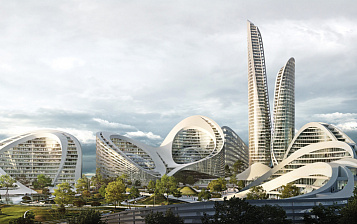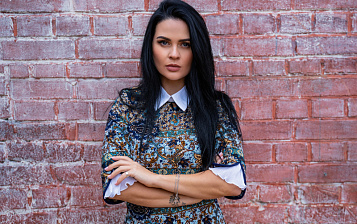The EQS is the first all-electric Mercedes-EQ luxury sedan. With this example, Mercedes-EQ is redefining this vehicle segment. In addition, the EQS is the first model built on a modular architecture for luxury and premium electric vehicles. With a seamless blend of technology, design, functionality and connectivity, the EQS will delight both driver and passengers. The EQS 450+ with 245 kW (combined electricity consumption according to NEFZ (New European Driving Cycle): 19.1-16.0 kWh/100 km; CO2 emissions: 0 g/km) and EQS will be the first to enter the market. 580 4MATIC with 385 kW (NEFZ combined power consumption: 20.0-16.9 kWh/100 km; CO2 emissions: 0 g/km). Consumption figures according to WLTP (World Harmonized Light Vehicle Testing Procedure): EQS 450+ has combined electric consumption of 20.4-15.7 kWh/100 km, CO2 emissions of 0 g/km; the EQS 580 4MATIC has a combined power consumption of 21.8-17.4 kWh/100 km and CO2 emissions of 0 g/km.
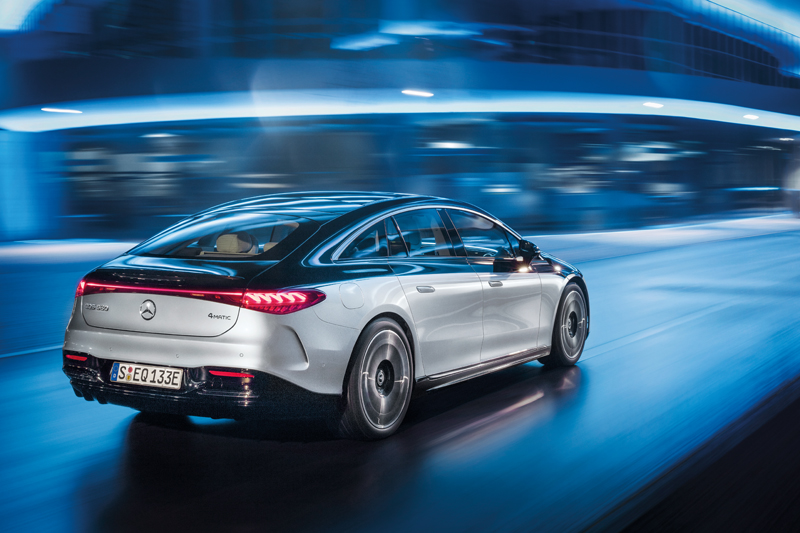
As part of its Ambition 2039 strategy, Mercedes-Benz is working to achieve zero CO2 emissions in all new vehicles rolling off the assembly line in less than 20 years. Already by 2030, the company intends to achieve that more than half of the cars sold will be electrified models – this includes both fully electric cars and plug-in hybrids. Mercedes-Benz is already thinking about tomorrow, and in many aspects at once. Therefore, the new EQS has been developed in accordance with the idea of sustainable development. It will be produced in a carbon neutral manner.
with the use of resource-saving materials, for example, rugs are made from fiber obtained from recycled materials. After all, Mercedes-Benz takes into account the entire value chain – from development to the supplier network and in-house production. Mercedes-Benz AG has scientifically validated its climate goals by contacting the SBTI (Science Based Targets Initiative = Science Based Targets Initiative).
Thanks to meticulous attention to detail and based on the principles of specialized design, aerodynamic experts, in close cooperation with designers, managed to achieve a new record value of Cx = 0.20. Thus, EQS is the best production car in the world in terms of aerodynamics. Especially from this benefits his power reserve. It is also among the best in the field of acoustic comfort: a significant contribution here is made by the very low noise level created by oncoming air flows.
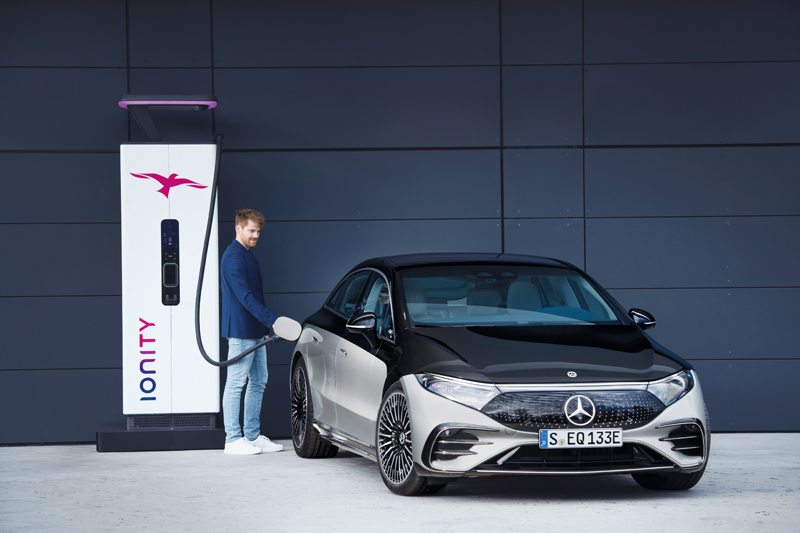
The EQS is also excellent in terms of recuperation: from a maximum deceleration in DAuto regen mode of 5 m/s2 to 3 m/s2 is achieved through recuperation (2 m/s2 due to wheel brakes). Thus, it becomes possible to decelerate to a complete stop without using the brake pedal. At the same time, this recuperation strategy and the high recuperation power (up to 290 kW) benefit the range. Slowing down is also carried out in front of detected vehicles ahead until they come to a complete stop, for example, at a traffic light. The intelligent recuperation system with "ECO assistant" works optimally in every situation and acts prudently, taking into account, among other things, the traffic situation and local topographical features. In addition, the driver can also manually switch between the three levels of recuperation and activate the coasting function using the paddles on the steering wheel.
From DC fast charging stations, the EQS is capable of charging up to 200 kW. In just 15 minutes, he will replenish his energy reserves, which will be enough for him to overcome another 300 km (according to WLTP). At home or from a public charging station, the EQS can be conveniently charged with AC up to 22 kW using the on-board charger. In Japan, the EQS is also capable of bi-directional charging, that is, charging in two directions. Plus, smart charging programs that can be activated automatically depending on the location of the car, and features that help reduce the load on the battery during charging.
With high-quality certificates of origin, Mercedes-Benz ensures that the electricity used for charging within the Mercedes me Charge service is supplied to the grid from renewable sources. This so-called Green Charging will become a permanent component of the Mercedes me Charge service from 2021. And Mercedes me Charge is capable of even more. Drive to a suitable charging station, open the hatch, plug in the plug and the power is on – that's how easy it is to charge your EQS car thanks to Plug & Charge. Other great features include the densest network of charging stations with over 500,000 charging points in 31 countries, of which over 200,000 are located in Europe. With IONITY Unlimited, all European Mercedes me Charge users will be able to use the network of fast charging stations free of charge for a year after activation.
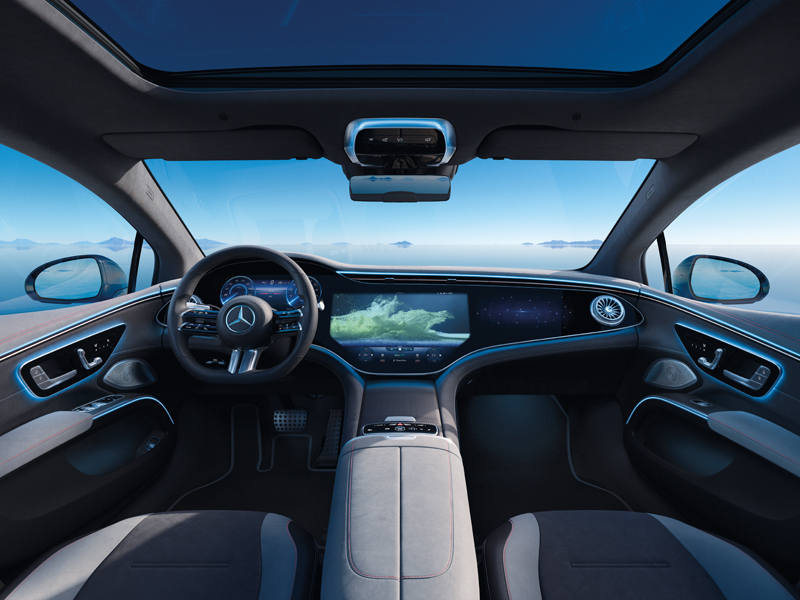
The Electric Intelligence-powered navigation system builds the fastest and most comfortable route based on a variety of factors, including stops for recharging, and dynamically responds to things like traffic jams or changes in driving style. An innovation here, which appears along with the EQS, is the indication in the MBUX (Mercedes-Benz User Experience) infotainment system that the available battery charge is sufficient to return to the starting point without recharging. When calculating a route, preference is given to manually entered charging stations located along it. The charging stations offered by the system can be excluded. For each stop for charging, an estimated cost is calculated.
Although the EQS is closely related to the new S-Class, it is still based on a purely electric architecture. This completely new concept has made it possible to consistently implement a special design: thanks to the design of the body in the form of a single long arc (One Bow) with a forward “cockpit” and a sloping, rear-sloping roof, the EQS is clearly distinguished from vehicles with an internal combustion engine at first glance. The design philosophy of "Sensual Simplicity" combined with "Progressive Luxury" is reflected in the graceful sculptural surfaces, in the reduction of joints and in organic, "seamless" (Seamless Design) transitions.
The front part of the body is made in the form of a single "Black panel". Innovative headlamps connected by a light strip and a black radiator grille (“Black Panel”, from the English Black Panel) form a unique look. The exclusivity of the radiator grille in Black Panel style with the Mercedes star in the center can be taken to an even higher level: it is also available as an option with a three-dimensional star pattern. This so-called Mercedes-Benz ornament is available in combination with the AMG Line or Electric Art exterior. This pattern goes back to the image of the very first star, registered in 1911 as a trademark of the Daimler-Motoren-Gesellschaft.
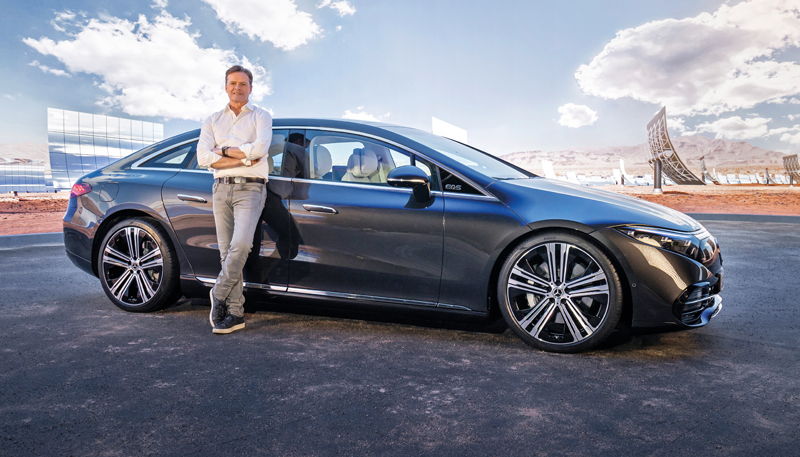
The EQS is the first Mercedes-Benz vehicle to be able to activate all sorts of brand new in-vehicle features via over-the-air (OTA) updates. With the release of the car, two special driving modes for young drivers and staff will be immediately available, several small games and a "Best or Nothing" demo program. Thus, after the purchase and initial configuration of the new EQS, part of its configuration can be adapted to personal preferences. It is also possible to unlock a larger steering angle, i.e. 10°, for the rear axle steering function. Along with the traditional purchase of individual features, it is also planned to use subscriptions, temporary activations and free trial periods.
By equipping the EQS with ENERGIZING AIR CONTROL PLUS, Mercedes-Benz is approaching the topic of air quality in the most comprehensive way possible. This system is based on four pillars: filtration, sensors, display concept and air conditioning. The HEPA filter (High Efficiency Particulate Air = high-efficiency air purification filter) with a very high degree of filtration cleans the air entering from the outside from fine dust, tiny particles, pollen and other substances. Thanks to the activated carbon coating, sulfur dioxide and nitrogen oxides are reduced and odors are eliminated. This HEPA filter has been certified by OFI CERT ZG 250-1 against viruses and bacteria. The pre-conditioning system allows you to clean the air in the cabin even before landing in it. In addition, the values for the fine dust content both outside and inside the vehicle are displayed in the MBUX system. Details about them can be found in a special menu dedicated to air quality. If the outside air quality is poor, the system may also advise you to raise the side windows and close the sunroof.
When the driver approaches the car, the door handles will first extend towards him. If you get closer, the driver's door will open automatically. In addition, the driver can also remotely open the rear doors via the MBUX system, for example, so that children can immediately get into the car after school.
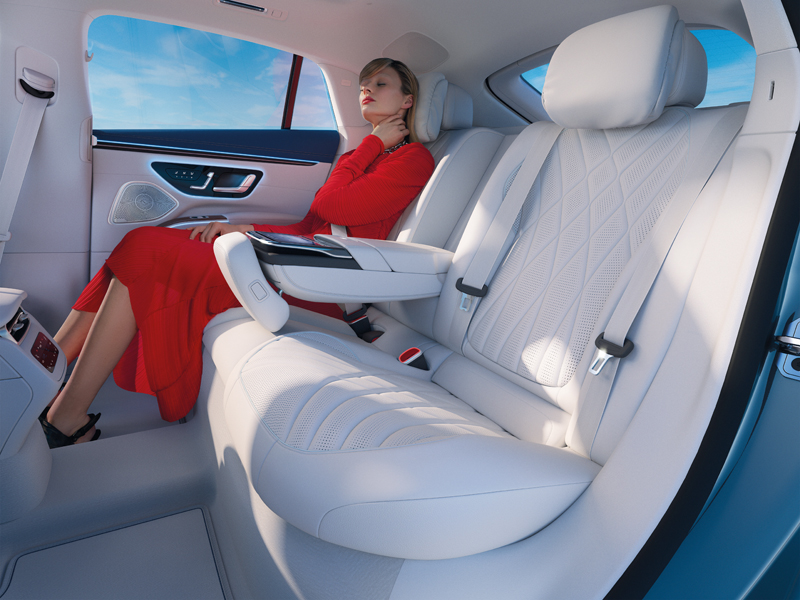
With a holistic approach to sound shaping, the paradigm shift – i.e. the transition from combustion engine to electric vehicle – is acoustically palpable in the EQS. Various soundscapes allow you to individually adjust the acoustics in the cabin. Paired with a Burmester® surround sound system, the EQS already features two soundscapes from the start: Silver Waves and Vivid Flux. They can be selected as sound effects on the center display, and can also be turned off. Another soundscape, Roaring Pulse, can be unlocked via over-the-air (OTA) updates. Within the selected soundscape, there is also an interactive driving sound played in the cabin through the loudspeakers of the acoustic system.
An innovation in the ENERGIZING COMFORT system is three ENERGIZING NATURE programs: "Forest Glade", "Sound of the Sea" and "Summer Rain". They will provide an immersive, that is, incredibly realistic sound experience in the car. These soothing soundscapes are the result of a collaboration with nature sound expert Gordon Hampton. As in the case of other ENERGIZING COMFORT programs, other senses are also affected by color and light solutions and images.
The agile and dynamic impression of the EQS is enhanced by the standard rear axle steering with up to 4.5° steering angle. An alternative variant with up to 10° rear wheel steer can be ordered or later unlocked via over-the-air (OTA) upgrade. This will reduce the turning circle of the EQS, which measures over five meters in length, to 10.9 meters, a turning circle common to many models in the compact class. The center display in the driving mode menu shows the current rear axle steering angle and the corresponding trajectories.
Thanks to an efficient system of sensors for monitoring the surrounding area, parking assistance systems can provide the driver with multifaceted support when maneuvering. The remote parking system allows the driver to use a smartphone to park the car and take it out of the parking space.
The revolutionary DIGITAL LIGHT headlight technology (included with Advanced Plus and above) makes it possible to project auxiliary markings or warning symbols onto the roadway. Two support functions are new here: an indication of the beginning of a joint lane change and a warning/direction indication when the lane keeping system or the blind spot monitoring system detects a danger. In each of the headlights, the DIGITAL LIGHT system contains a light module of three ultra-high-power LEDs, whose light is refracted and directed through 1.3 million microscopic mirrors. Thus, the total resolution of the headlights is over 2.6 million pixels.
In combination with the DRIVE PILOT option, the EQS will be able to drive at high traffic density or in traffic jams on the respective autobahn sections, initially in Germany, in a highly automated mode at speeds of up to 60 km/h. This will relieve the driver and free up time for him, giving him the opportunity to do other things in parallel, such as browsing the web or processing e-mail within the "Office in the car" (In-Car-Office).
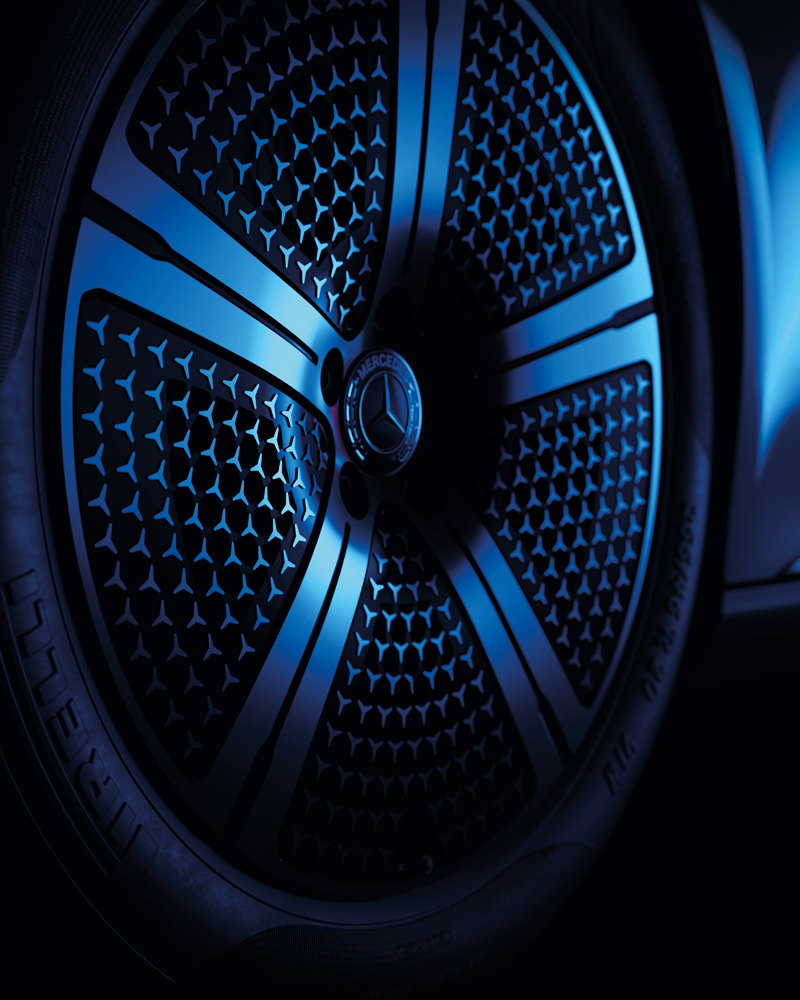
The absolute highlight of the interior equipment program is the MBUX Hyperscreen display (optional). This large, curved display module spans nearly the entire width of the cabin, from one A-pillar to the other. Located under a common outer glass, the three displays visually merge together. An OLED display with a diagonal of 12.3 inches forms its display and control area for the driver. Availability of entertainment functions on it while driving is determined solely by the requirements of local laws. In doing so, the Mercedes-EQ relies on an intelligent locking logic using the camera: as soon as the camera detects that the driver is looking at the front passenger display, it will automatically dim depending on the nature of the content.
With learning-capable software, the MBUX system is fully customizable to its user and makes personalized suggestions for a host of infotainment, comfort and in-car features. In the case of the so-called zero level, it is about displaying key applications - always depending on the situation and context - at the highest level of the MBUX system in the user's field of vision.
The latest generation of assistance systems includes a wide range of functions to support the driver. A novelty here is, for example, an additional warning about the second falling asleep of the ATTENTION ASSIST system. Via a camera in the driver display (only in conjunction with MBUX Hyperscreen), this function analyzes the driver's blink rate. The display on the driver's display in full screen mode clearly shows how a particular assistance system works.
The principles of "Integrated Safety", especially safety in case of accidents, apply regardless of the platform. Therefore, the EQS, like all other Mercedes-Benz vehicles, has an impact-resistant passenger compartment, special crumple zones and modern passive safety systems (retaining the driver and passengers). The PRE-SAFE® preventive safety system is part of the basic package. The all-electric architecture at the heart of the EQS has also opened up new design possibilities for its safety concept. So, as an installation space for the battery, the designers were able to choose an area in the underbody, more protected in the event of an accident. And since there is no large engine block, the behavior of the car in a frontal collision is even easier to calculate. In addition to the standard crash tests, the TFS also checked additional load cases that occur in various crash situations, as well as extensive component testing.


 DOWNLOAD
DOWNLOAD LOOK
LOOK Top Content of the Month
Top Content of the Month